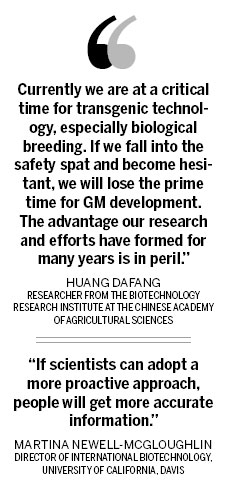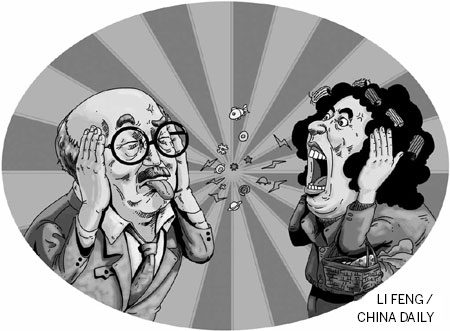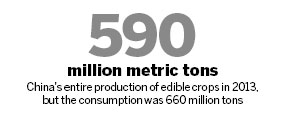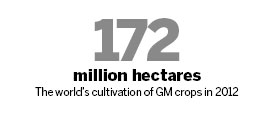
The onus of convincing a distrustful public of the benefits of this technology lies with scientists, policy makers and opinion leaders, reports Zhang Lei.
Looking back, 2013 has proven to be a turbulent but also an inspiring year for genetically modified (GM) food. As public doubt over GM safety continues, the Ministry of Agriculture finally stepped in last month, proclaiming they will make greater effort in applying stricter standards on GM food and keeping the consumers well informed.
But more importantly, the ministry said the country will not fall behind in the field of transgenic technology development.
According to Chen Xiwen, deputy chief of the Central Rural Work Leading Group, transgenic molecular-scale seed breeding technology is in the vanguard of world life science.
Another shot in the arm for GM scientists is the support from Yuan Longping - China's "father of hybrid rice".
He dropped a bomb last month, saying he is working with other scientists on transforming a certain gene of corn into rice, which would improve photosynthetic efficiency and output. And it was also the first time he proclaimed publicly that transgenic technology is the trend.
Huang Dafang, a researcher from the Biotechnology Research Institute at the Chinese Academy of Agricultural Sciences who was repeatedly targeted by an anti-GM lobby, said it is a waste of time to be dragged into the public spat.

"Currently we are at a critical time for transgenic technology, especially biological breeding. If we fall into the safety spat and become hesitant, we will lose the prime time for GM development. The advantage our research and efforts have formed for many years is in peril," he said.
"The worst result would not only be our biological breeding market controlled by foreign countries. Once a threat to national security such as droughts or severe natural disasters occurs, which is constantly recurring in Chinese history, there won't be enough food, so the consequences could be disastrous."
As China's urbanization accelerates, its food security is hitting its bottom line. According to Huang, the self-sufficiency rate was 95 percent several years ago, but it dropped to less than 90 percent last year. The entire production of edible crops was 590 million metric tons in 2013, but the consumption was 660 million tons. The gap of 70 million tons had to rely on imports. The past few years have seen increasing imports of soybeans and corn.
Duan Ziyuan, professor at the Institute of Genetics and Developmental Biology, CAS agreed that the key to food security lies in biological breeding technology. Statistics from the Food and Agriculture Organization of the UN show that 80 percent of the world's total grain output increase is dependent on improving yield per unit.
"Biological breeding really made a great contribution to our food security. The use of a semi-dwarf gene by Yuan increased the crop yield by 20 to 30 percent. Application of heterosis in breeding also increased the yield by more than 20 percent," Duan said.
"In fact, the contribution rate of biological technology to crop yield is 53 percent. It also applies to meat supply. For example, crossbred pig technology enabled a full-grown pig to have a ketone body weighing 92 kg in 2011, an increase of 61.4 percent from the 57 kg in 1931. Breeding technology has proven more effective than simply improving soil fertility."
Duan believed a switch from the traditional crossbreeding to transgenic molecular-scale seed breeding technology is crucial. He said crossbreeding is experiencing a bottleneck, because after years of experiments, genetic diversity is very narrow among crossbred seeds, and it usually takes more than a decade to cross out the bad traits. Molecular breeding has a better control over the seeds' genome information, such as the Bt gene for anti-pest crops. The Bt gene has the resistance gene inserted into plant cells, so that scientists can effectively realize the desired trait.
In 2012, the world's cultivation of GM crops hit 172 million hectares, and GM acreage was bigger in developing countries than in developed countries. The top four crops are corn, soybeans, cotton and rape. Of all the farmers who plant GM crops, 90 percent are small farmers in developing countries with limited resources. This in turn shows the value of transgenic technology.
The value of the world's entire transgenic industry reached $15 billion, and according to Martina Newell-McGloughlin, director of International Biotechnology, University of California, Davis, it still maintains a very rapid growth.
China last year planted almost 4 million hectares of GM pest-resistant cotton. The variety has many perks, one being the capability to increase production per unit by 10 percent, and a reduction of 60 percent in insecticide use.
Traditional cotton is prone to suffer from pests. This variety is expected to bring along economic benefits of $1 billion, which is a major contribution to China's national economy. Farmers are immune from the hazard of inhaling pesticides when they misuse the spraying equipment. Newell-McGloughlin estimated that the total value of such cotton variety should reach $13 billion this year worldwide. Another advantage of the GM cotton is the improvement of the quality of cotton fiber.
GM papaya is the second crop China allowed commercialization within its territory, because traditional papaya is quite vulnerable to ringspot virus. So far there is no single natural way to kill worms that carry such a virus. But with the use of RNA interference technology, scientists can effectively solve this problem. China in 2013 cultivated more than 6,000 hectares of GM papaya.
As for the staple food of the Chinese, rice has yet to be approved by the government for nationwide commercialization, although two varieties of GM rice have been given safety certificates by the Ministry of Agriculture.
If commercialized, Newell-McGloughlin said it is expected to bring $40 billion in potential gains to China. "Not only can the insect-resistant rice reduce 80 percent use of pesticides, in the Davis campus we isolated the gene Xa21 to be able to effectively resist the blight of rice. The gene is isolated from cassava. If it can be inserted into Chinese indica rice, it will enhance 10 times the ability of insect-resistance," she said.
By 2050, the world population will reach 9 billion, and food demand will increase by 70 percent, compared with the current level. In view of this nonreversible trend, Newell-McGloughlin believed scientists should set a timeline for activities to popularize scientific knowledge on GM. Over the past few years, Chinese scientists have passively responded to rumors spread across the nation. She suggested that scientists go out with policy makers and opinion leaders to explain the benefits brought about by GM technology. "If scientists can adopt a more proactive approach, people will get more accurate information," she said.
Despite all these advancements, it is still difficult to quell the public distrust for GM scientists. Public figures have a great influence on the public's judgment. After several rounds of unresolvable spats on the Internet with another opinion leader Fang Zhouzi, famous TV presenter Cui Yongyuan, an anti-GM enthusiast, spent 500,000 yuan ($82,653) to embark on a journey to the US for what he called independent investigation. His conclusion is that most Americans are also kept in the dark as to GM safety. And the online opinion showed nearly 100 percent sided with him.
Similar to the situation in the US, you can hardly find any member of the anti-GM lobby that has a scientific research background. "They don't have scientific evidence to support them, so they resort to rumors or outdated data," Newell-McGloughlin said.
She believes random street investigation may be misleading. She suggested Cui should go to the International Food Information Society for more information. The institute every two years conducts a consumer survey on food safety.
They strictly control research techniques to ensure that their questions are neutral. In addition, investigation should at least involve 1,000 people with a strict monitoring of their gender, academic ground and professions.
It is for these reasons, the University of California, Davis established a team of scientists working with the media and set up a website with more than 700 articles on transgenic evaluation detailing the safety concerns.
The year 2013 also marked the 60th anniversary of the discovery of the DNA double-helix structure, the basis for all GM technologies. Since the advent of GM crops in 1996, humans have consumed more than 2 trillion copies of GM modified foods, and most of them are consumed in the US. More than half of its supermarket foods contain genetically modified ingredients. Meanwhile GM corn and soybeans are also fed to pigs, cattle and chickens in the US. In fact, China has stricter standards on GM product labeling, while the US Food and Drug Administration does not require a mandatory GM logo on the product.
Contact the writer at zhanglei@chinadaily.com.cn




(China Daily 02/04/2014 page8)